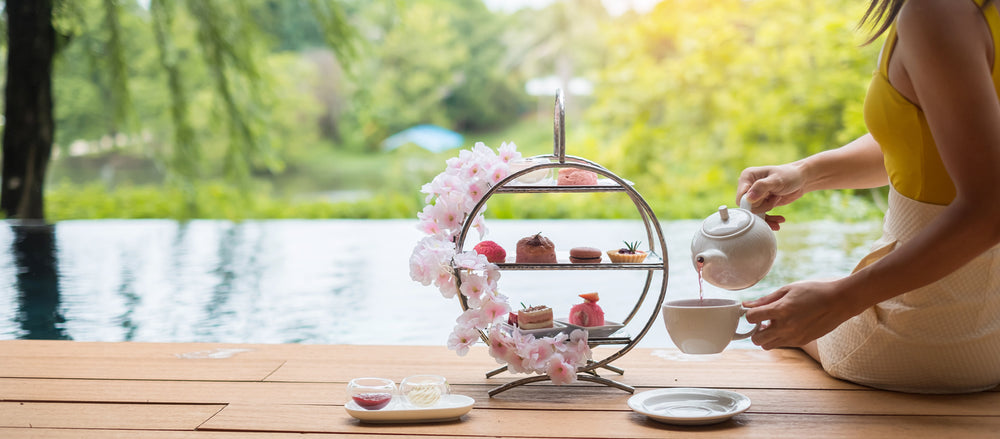A famous English author Arthur Gray once said, “The spirit of the tea beverage is one of peace, comfort and refinement.”
Tea holds immense historical relevance in Britain, shaping social customs and leaving an indelible mark on the nation's cultural landscape. Its introduction in the 17th century marked the beginning of a love affair that has endured for centuries. The tea trade played a significant role in the expansion of the British Empire, with tea becoming a symbol of British identity and influence across the globe. The popularity of afternoon tea during the 19th century cemented tea's place in British society, provided a space for socializing, and displayed social status. The rituals and etiquette associated with tea became an essential part of British etiquette, reflecting the country's refinement and appreciation for tradition. Today tea remains a cherished beverage, connecting generations and serving as a reminder of Britain's historic ties to tea-producing regions and its enduring passion for this beloved drink.
A Sip Through Time: The Captivating Journey of Tea in British Culture

Tea's introduction to British society can be attributed to Catherine of Braganza, the Portuguese princess who married King Charles II of England in 1662. Catherine was known for her love of tea and brought this cherished beverage with her to the British court. Initially seen as an exotic luxury, tea quickly captivated the aristocracy and became a symbol of wealth and sophistication.
The British East India Company played a significant role in tea's popularity. They initially began importing tea from China as a medicinal herb, but its refreshing taste and stimulating properties appealed to the British palate. As tea imports grew, the East India Company established a monopoly, controlling the trade and distribution of tea.
By the 18th century, tea had become a staple in British society. Tea houses sprouted up, providing places for social gatherings and discussions. The ritual of afternoon tea gained prominence among the upper classes, complete with delicate china, scones, and finger sandwiches.
Tea's popularity also had an impact on British politics. High taxes imposed on tea led to smuggling and, ultimately, the infamous Boston Tea Party in 1773, a catalyst for the American Revolution.
Today, tea remains deeply ingrained in British culture, and people from all walks of life enjoy it. It is an integral part of daily life, offering comfort, conversation, and a connection to centuries of tradition.
A Cup of Tradition

Traditional afternoon tea is a delightful ritual that features a selection of teas accompanied by scones, pastries, and finger sandwiches. Many households begin their mornings with a cuppa, often with milk and sometimes sugar. Tea is a common beverage served during social gatherings, both casual meetups and formal occasions. British tea preferences range from classic black teas like English Breakfast and Earl Grey to herbal infusions and specialty blends. It has a comforting and ubiquitous presence in teahouses, cafes, and homes that fosters conversation and offers a moment of relaxation in modern British life.
From Kettle to Cup

The preparation and presentation of tea are essential aspects of the art of British tea.
To make a classic cuppa, boiling water is poured over a tea bag or loose tea leaves in a teapot or mug. High-quality loose-leaf tea is preferred, as it allows for a richer and more nuanced flavour. It is left to brew for a few minutes, allowing the flavours to infuse. The tea is then often served with a splash of milk, and sugar is added according to personal preference. In formal settings or afternoon tea, it is often served in elegant teacups on saucers accompanied by a small plate of biscuits or cakes. Milk is traditionally added to the tea after pouring to prevent scalding. The tea is enjoyed leisurely, sipped slowly, and savoured for its comforting warmth and delightful flavour.
Accompanying the tea are various accoutrements that add to the experience. Fine bone china teacups and saucers are used along with silver teaspoons and delicate sugar tongs. Milk and sugar are offered as options for personalizing the tea to individual taste preferences. The process of pouring tea is an art where the teapot is held in a specific way to pour, and a strainer is used to prevent leaves from entering the cup.
Tea Time Temptations

Beyond the traditional afternoon tea, the British also embrace the ritual of "elevenses," a mid-morning break for tea and a light snack. This tradition is thought to have originated in the working-class culture and remains a cherished part of British daily life. It provides a moment of respite and allows individuals to recharge and socialize before continuing their day.
Delectable treats are served alongside the tea. Finger sandwiches with various fillings, such as cucumber, smoked salmon, or egg salad, are a staple of afternoon tea. Scones with clotted cream and strawberry jam are also enjoyed with tea. These delicacies are often served on tiered cake stands, adding an elegant touch to the presentation.
The Serenity of Tea and Elegance of Tea Dances

Tea gardens in Britain are serene outdoor spaces where individuals enjoy tea amidst nature. These gardens are picturesque outdoor settings where tea is served amidst lush greenery and blooming flowers, offering a peaceful retreat for tea enthusiasts.
Tea dances are social events where people gather to dance and enjoy tea in an elegant setting. These dances became popular in the early 20th century and provided an opportunity for individuals to socialize, indulge in tea and showcase their dance skills.
The Artful Brew

The art of British tea has experienced a remarkable revival in recent years, witnessing the emergence of tea rooms and specialty tea shops throughout the nation. These establishments focus on offering a refined and authentic tea experience. They emphasize the importance of quality teas, proper brewing techniques, and attention to detail.
The art of British tea is a testament to the enduring charm and elegance of this beloved beverage. It is a window into British history, culture, and traditions. From the refined rituals of afternoon tea to the carefully curated selection of teas and treats, the art of British tea offers a glimpse into a world of sophistication and timeless grace.
Here’s a popular joke on tea:
Why did the tea get promoted?
Because it was steeping up in the company!


 Christmas 2025
Christmas 2025
 Frozen Food
Frozen Food
 Baking
Baking
 Beans, Peas, Soups & Tins
Beans, Peas, Soups & Tins
 Biscuits, Crackers & Cookies
Biscuits, Crackers & Cookies
 Candy / Sweets
Candy / Sweets
 Crisps & Snacks
Crisps & Snacks
 Chemist / Pharmacy
Chemist / Pharmacy
 Desserts
Desserts
 Gravy, Stock & Paste
Gravy, Stock & Paste
 Haggis
Haggis
 Indian Sauces, Paste and Pickle
Indian Sauces, Paste and Pickle
 Jams & Preserves
Jams & Preserves
 Poppy Appeal
Poppy Appeal
 Pot Noodles & Super Noodles
Pot Noodles & Super Noodles
 Scone Mix
Scone Mix
 Gluten-Free / Free From
Gluten-Free / Free From
 Tea Accessories
Tea Accessories
 Teapot & Tea sets
Teapot & Tea sets
 Tea For One
Tea For One
 Sugar & Creamer
Sugar & Creamer
 Tableware
Tableware
 Serveware
Serveware
 Plates & Trays
Plates & Trays
 Bowls
Bowls
 Cups & Saucers
Cups & Saucers
 Mugs
Mugs
 Silverware
Silverware
 Dinnerware - Accessories
Dinnerware - Accessories
 Dinnerware - For Pets
Dinnerware - For Pets
 Victoria Eggs - Hand-Drawn UK Homeware
Victoria Eggs - Hand-Drawn UK Homeware
 Jewelry & Accessories
Jewelry & Accessories
 Sale
Sale
 Christmas Gifts
Christmas Gifts

